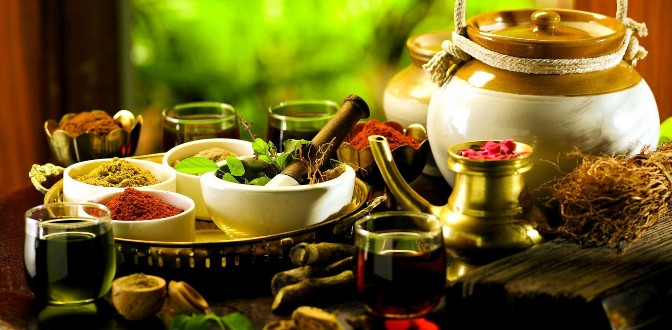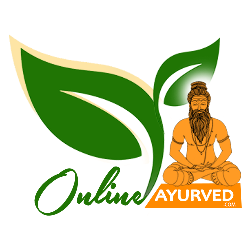Ayurveda
Ayurveda, the knowledge of life and longevity, arises out of a 5000 year old culture that recognized Nature as its Mother. Immersed in Nature’s continuous, rhythmic flux, the Vedic seers living in the Indian Subcontinent cognized Nature’s principles and powers and applied them to the body-mind-spirit dynamic which they understood humans to be. Nature’s ways could and must be applied to humans because they understood humans to be part of Nature’s expression. This the seers knew through direct experience of Reality, an experience revealing, among other things, that every planet, every star, every natural force – wind, fire, death and the like – was a living, conscious being.

One of the ways these Vedic seers described their experience of this astonishing Reality that birthed conscious life was to call it, “the true, the harmonious, the vast.” Reality exists (it is true); it has a natural order or rhythm which is self-perpetuating and self-correcting (it is harmonious); and it is all-pervasive, extending beyond the farthest reaches of the human imagination (it is vast).
Ayurvedic seers understood that the macrocosm of the external universe and the microcosm of the human body, that universe of 50 – 100 million cells, have the same diversity and complexity of existence. The human body when healthy is harmonious, self-perpetuating and self-correcting. In their vision, the purpose of Ayurveda is to provide the means for humans to align themselves with Nature, which results in harmony and alignment between the microcosm and the macrocosm. The individual microcosm then functions as harmonious unit of the greater universe, and health results. Conversely, where there is disharmony, there is disease.
The breadth of Ayurveda’s vision is complemented, now as it was then, by its precision. Thus Ayurveda is able to provide practical answers to important questions such as: What is Life? What is Health? What is Disease? These answers, the understanding they flow from, and the innumerable individualized remedies and therapies they offer, form the living, ever-evolving body of Ayurveda that is available to all those who are interested in curing and preventing disease, improving their lives and deepening their well being.
QUALITIES
To better understand how Ayurveda may serve you, it is helpful to know that Ayurveda doesn’t look upon you as a machine (however refined), or as an isolated unit, a statistical probability, or as a compilation of diseases and malfunctions. Ayurveda perceives you as a distinct whole whose body-mind-spirit dynamic is in constant interaction with Nature. You have a unique and innate balance which can become disrupted and can be restored to harmony. You are perceived as capable of knowing and becoming free in your true nature.

Though quantitative and precise, Ayurveda essentially diagnoses, treats and prescribes in terms of qualities. Ayurveda perceives all matter, including thoughts and emotions, to be composed of varying ratios of five primordial elements, all of which have qualities. These five elements are effectively translated as: earth, water, fire, air and ether. They are all states of matter. Earth represents the solid state of matter; water the liquid state; air, the gaseous state; fire, the power to change the state of any substance; and ether, the field that is the source of all matter and the space in which matter exists.
Everything is composed of these elements and they all have qualities in common, manifesting them in differing degrees and proportions resulting in the countless unique individualities in creation, of which we are one. Elements and their qualities reside as naturally in us as they do in the rest of Nature. By focusing on qualities and their relationships, Ayurveda treats at once our body-mind-spirit and our relationship to the environment. It can do this because qualities cut across conceptual distinctions such as body and mind, inside and outside.
For instance, an Ayurvedic physician looks at an herb in terms of its qualities. Is it cold or hot? Heavy or light? Static or mobile? Depending on the herb’s qualities, it is either suitable or not for the client, who is also looked at in terms of qualities, as is the environment in which he lives. Is the client by nature mentally and physically cold or hot, heavy or light, static or mobile? Is his geographic location hot, arid or humid? Looking at Life in terms of its qualities and the law by which they interact, the Law of like increases like, gives Ayurveda powerful means to analyze and balance a person and the interaction between the person and the environment.
“Like increases like” is a simple principle. Our bodies respond to an external stimulus in relationship with the nature of that stimulus. If we lie in warm sunlight, our body becomes warmer because our own quality of warmth is increased by the quality of the stimulus the sun provides. This is true of everything we experience – food which is sweet increases our internal quality of sweetness, the seasons increase heat, moisture, dryness or cold depending on whether it is summer, wet springtime, windy season or winter, and so on.
Every stimulus increases “like” parts of our being and decreases those parts of us that are “unlike” it, and treatment to address imbalances is therefore in large part a matter of providing the body with substances and experiences having the qualities which match the quality we need to have increased or decreased in our body. An Ayurvedic physician will determine our innate qualities, and identify those which are balanced and those of which we have a temporary excess or deficit. She will then prescribe a treatment which may include diet, supplements, physical routines, and suggestions for environment which together address that excess or deficit.
For example: Suppose we have an excess of “hot” in us. We feel angry, our skin is ulcerated, our words are sharp and our hunger constant. The Ayurvedic physician, recognizing Nature works according to the principle “like increases like”, determining we have an innately “hot” constitution, and finding out that for the past two weeks we have been working outside under the summer sun, stopping only to eat hot, spicy food, would inform us we are inflaming our already innately hot constitution by our lifestyle choices. She then would provide us with cooling measures to restore our balance, calm our mind, soothe our digestion and rescue our skin.
When any substance, including time and space, impacts upon us, its qualities, innate and added, influence our systems. Ayurveda recognizes ten important pairs of opposing qualities that influence living organisms. Each of these pairs of dualities defines a continuum of activity.
QUALITIES |
CONTINUUM |
| heavy and light | Weight |
| cold and hot | Temperature |
| oily/moist and dry | Emolliency |
| slow/dull and intense | Intensity |
| stable and mobile | Fluidity |
| soft and hard | Rigidity |
| clear and sticky | Adhesion |
| smooth and rough | Texture |
| subtle and gross | Density |
| solid and liquid | Viscosity |
Each quality is a tendency, and implies movement toward or away from one of the poles of the continuum. Ayurvedic analysis and treatment is concerned with the relative extremes which are possible within the body, not with any absolute state represented by the pole. The extremes of each quality, say hot and cold on the continuum of temperature, are engaged in a continual tug of war, each attempting to move further in its direction the body which is the site of the struggle. And every being impacted by a relative extreme responds to it differently depending on the configuration of qualities that comprise their constitution.

In Ayurveda, an apple possesses the qualities of dry, light and cold. An individual who is predominately light, dry and cold would become more so after eating an apple than would a person who is primarily heavy, moist and hot. Since the individual organism is the point of reference for everything it experiences, there is no point on any of the continua which is good or bad without reference to the individual constitutional makeup.
DOSHAS
Knowing what qualities naturally predominate in us is an important first step for achieving, maintaining and improving our health. To do this, we must determine our dosha, i.e. our Ayurvedic psychophysiological constitution. Based on this knowledge, we can take appropriate measures to attain and maintain our balance.
The five elements have three active forms called doshas: Vata, Pitta and Kapha. Vata arises from air and ether, Pitta from fire and water, and Kapha from water and earth. Each dosha is associated with certain qualities. Vata is dry, light, mobile, clear, rough and subtle. It is in charge of all motion in the body and mind. Everything that moves, moves because of Vata. Pitta is slightly oily, hot, intense, light, fluid and liquid. It is in charge of all transformation in an organism. Digestion, both of food and ideas, is an example of Pitta activity. Kapha is oily, cold, heavy, stable, smooth and dense. It lubricates, maintains, contains and nourishes. All five elements, as expressed through the doshas, Vata, Pitta and Kapha, are essential to life. When balanced, the three doshas cause an organism’s elements to function together; when unbalanced, they can create chaos.
QUALITIES OF DOSHAS
| Vata | Pitta | Kapha |
| dry | oily | oily |
| cold | hot | cold |
| light | light | heavy |
| irregular | intense | stable |
| mobile | fluid | viscous |
| rarefied | malodorous | dense |
| rough | liquid | smooth |
No one dosha can produce or sustain life; all three must work together, each in its own way. Every human is made up of all three doshas, but the strength or the predominance of the doshas is different in every individual. Our unique ratio of the doshas is determined primarily at the moment of our conception and is known as our Prakruti, our psychophysiological constitution.
A person could be born with a predominately Vata constitution, or he might have two doshas predominating, which is most often the case. Knowing our Prakruti can help us make clear and wise choices to achieve and maintain our optimum health because then we are able to determine what in ourselves and in our environment promotes balance in us.
There are eight constitutional types:
Vata, Pitta, and Kapha, where each one predominates alone in the body,
Vata-Pitta/Pitta-Vata, Pitta-Kapha/Kapha-Pitta, and
Vata-Kapha/Kapha-Vata, where two doshas share domination in the body,
Vata-Pitta-Kapha, where all three doshas predominate equally, but tend to imbalance, and
Vata-Pitta-Kapha, where all three doshas predominate equally and tend to remain balanced.
Most people have a dual predominance, with one of the two doshas slightly or significantly stronger than the other. Everyone has some amount of all three doshas in their constitution. The proportions with which each dosha is found in any individual constitution provides for an infinite variety of characteristics, which is part of Ayurveda’s explanation for the wonder of a world in which each and every individual is unique.
The Ayurvedic system of constitutional analysis is simple, but not simplistic. It is an elegant tool for self-analysis and development that yields a wealth of information about our metabolic tendencies, and how those tendencies affect us. These tendencies, which are so deeply ingrained that they form a permanent constitution, need to be actively balanced if we are to remain healthy and harmonious.
The Table of Constitutions below is presented to help you in a preliminary determination of your Prakruti (constitution). Everyone has inherent constitutional strengths and weaknesses. If you know yours, and know how your Prakruti causes them, you can adjust for them and make your life happier and healthier. When you evaluate yourself, see yourself as you are, not as you would like to be. Because Prakruti is fixed at the moment of conception, look at the tendencies that have persisted in you from childhood. Whenever you cannot decide on a tendency, or if it seems that you shift between tendencies, e.g. if your speech is sometimes rambling, sometimes purposeful, sometimes slow and cautious, score yourself as Vata for that characteristic.
The most reliable characteristics are generally those that are most physical as they are the hardest to ignore. Being honest in this self-evaluation will not only result in a potent tool for your well-being, it just might explain why a health regime that worked so well for your friend produced few, if any, benefits for you. What works well for one constitution can wreak havoc in a different constitution.
People with Vata dominating in their lives are governed mostly by the key characteristic of Vata, which is movement. Movement implies change, and changeability, and Vata people have plenty of both. They tend to complete activity quickly, to change from one activity to another both frequently and rapidly.Their moods and emotions shift rapidly, and their minds tend to be restless and inconstant. Because of the power of the force of movement, Vata people will use up whatever energy they have on whichever of the many interesting possibilities strike their fancy at the moment; expending energy until there is nothing left in the reservoir, at which time they must retire while waiting for a new store of energy to accumulate.
Their physical bodies change rapidly too: digestion may be excellent on one day, and poor the next; sleep may be deep and sound at times, and light or non-existent at others. Vata energy is made up of endless cycles of boom and bust, the boom full of creativity, learning, action and enthusiasm, the bust the quiet time of recuperation and retreat.
Because Vata carries the quality of dryness, Vata people tend to have dry skin which is rough and cracks, joints which creak and pop, and constipation is often present. They are more cold blooded than Pitta or Kapha people, and so tend to love heat, light, and hot weather, and can suffer miserably in cold climates (especially cold, dry, windy climes). They are usually thin, and find it difficult to gain weight.
This factor, coupled with irregular and changeable eating habits often leads to cellular anxiety due to the erratic supply of nutrients they receive, which in turn can create fear and anxiety as the dominant negative emotion for Vata people. They have imaginative minds, are exciting and excitable, and can be both extroverted and introverted. Vata is the most difficult constitution to keep healthy due to the excessive patterns of energy use, but when balanced, a Vata person is a good creative and original thinker, mentally alert, may be inspired, and is quick to process and imagine.
Pitta people are governed largely by the quality of heat, which gives them warm, soft skin which will generate freckles, rashes, pimples, moles and wrinkles more readily than Kapha or Vata dominant types. They tend to dislike heat, preferring cold climates, enjoying winter sports, and gravitating to cooling foods (unless they have become addicted to the stimulation of hot, spicy food). They are efficient and precise in their mentation and physical orientations, and can be strong-willed, opinionated, and forceful with their ideas and actions. Their innate heat makes them easily irritated, tending to intolerance of disagreement and impatience with those who are less organized and efficient than themselves.
They love to eat, and do not tolerate hunger well. The value Pitta people place on regularity and perfection can lead them to a pattern of criticism of self and others, and the tendency to be completely focused on goal attainment often leads to a willingness to sacrifice everything else to the icon of achievement. When balanced, Pitta’s natural heat creates courage; otherwise it results in anger, especially when they are hungry. Physical and mental heat creates most disease for Pitta types, and a balanced Pitta is decisive, methodical, practical, and able to digest food, ideas and feelings in great measure.
Kapha governs the quality of stability and structure, and Kapha dominant people reflect these characteristics more strongly than other doshic types: they tend to gain weight easily and lose it with difficulty. The tissues of the body are usually firm, healthy and ample. They sleep deeply and often may experience difficulty becoming active in the morning. In fact, all of their behavioral patterns reflect stability and slowness: Kapha people walk, talk, eat and digest slowly.
They also learn slowly, but once having mastered something, will not forget. The earth and water elements which combine in Kapha lead them to dislike damp cold climes. They are prone to sinus trouble, and to congestion throughout the body, in both the chest and digestive organs. However, Kapha people are fundamentally strong, and their stamina is better than either Vata or Pitta types.
They can skip meals without physical discomfort, but usually don’t, because food is one way to soothe the strongly emotional personality which is hidden underneath a typically placid and calm external presentation. They are usually able to prosper without much effort, and seem to attract wealth and possessions to themselves. They are most able to retain wealth of all the types, but may, when out of balance place too much emphasis on material possessions. A balanced Kapha is durable, dependable, calm, and compassionate, the kind of person you want to have managing the office.
TABLE OF CONSTITUTIONS
|
Characteristic |
Vata | Pitta |
Kapha |
| Body frame | thin, irregular, proportionate | medium, usually well-proportioned | broad, heavy |
| Weight | easy to lose, hard to gain | easy to lose, easy to gain | hard to lose, easy to gain |
| Skin | dark or tans deeply, often cold to touch | light, sunburns easily, warm to touch | medium shade, tans easily, cool to touch |
| Sweat | scanty, even in heat | profuse in heat | moderate, consistent |
| Hair | dry, coarse, curly, often dark | fine, often straight, light color, may be oily, tends to go gray or bald early | oily, lustrous, thick, usually brown |
| Eye Color | gray, violet, slate-blue | hazel, green, light or electric blue | brown, occasionally blue |
| Appetite | variable | intense | regular |
| Evacuation | erratic, often constipated | usually regular, sometimes loose | regular, slow |
| Climate | prefers warm | prefers cool | enjoys changes of season |
| Stamina | poor, tends to be medium, overexert | overexerts when competing | good, tends to under exert |
| Sex Drive | variable | often intense | steady |
| Fertility | poor | medium | good |
| Sleep | variable, often poor, deep when tired | sleeps easily, rises easily | sleeps easily, rises with difficulty |
| Speech | talkative, may ramble | speaks purposefully | slow, cautious |
| Emotion | fear often primary | often afflicted with anger | likes to avoid confrontation |
| Thinking | usually verbal | lots of visual imagery | frequent use of feelings, emotions |
| Memory | learns quickly, forgets quickly | learns quickly, forgets slowly | learns slowly, forgets slowly |
We have mentioned eight broad Ayurvedic constitutional types and described three. You may have recognized one of these doshas as more influential in you than the other two. Most likely, you have a double predominate Prakruti and one of the doshas is more influential at different times. An Ayurvedic physician’s diagnosis of your dosha and your current state of health is a much more in-depth procedure and therefore the balancing and treatment procedures would be both more individualized and comprehensive. Yet to give you some idea of the Ayurvedic orientation, here are a few broad balancing guidelines for predominate doshic types. Following the one most appropriate for you will help you achieve and maintain general constitutional balance.
